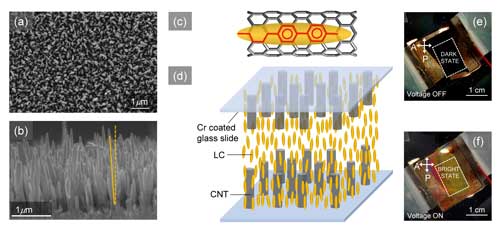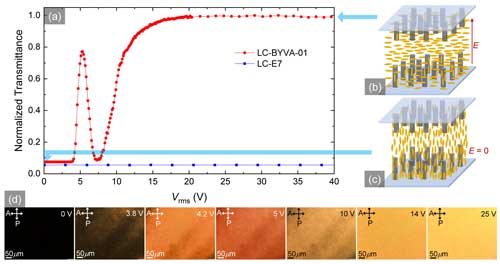| Aug 19, 2020 | |
Vertically aligned carbon nanotube arrays stabilize homeotropic liquid crystal devices |
|
| (Nanowerk Spotlight) Liquid crystals (LCs) are optically anisotropic materials, and they are widely used in electro-optical display technology, known as liquid crystal displays (LCDs). | |
| Understanding the alignment phenomena of a nematic LC on nanostructured surfaces remains an important area of research, as the alignment process determines the LC’s molecular orientation and conformation—which influence the LC’s optical and electro-optical characteristics in modern LCDs. | |
| In vertical-alignment (VA) LC devices (also called homeotropic LC devices), the LC material is initially aligned perpendicular to the substrates, and the application of an electric field perpendicular to the substrates can reorient the LC parallel to the substrate. This operation requires the LC material to be negative dielectric anisotropic so that it can align perpendicular to the electric field. | |
| These VA LCDs have many advantages compare to the traditional planar-nematic displays, such as a deeper black background, a higher on-axis contrast ratio, rubbing-free process, a wider viewing angle, and simultaneous usability of reflective and transmissive modes. | |
| Conventionally, polyimide (PI) layers are used as the vertical-alignment agent in standard VA-LCDs, where the LC molecules align with the vertical part of the alkyl side chains of the PI layers. Consequently, the nematic phase achieves a homeotropic director profile inside the device. However, these organic PI alignment layers have some disadvantages. | |
| For example, the PI layers are responsive to UV light and high temperature, and therefore, the alignment characteristics are affected when the PI-based LC devices are exposed to UV light and high temperature. Thus, various inorganic alignment-agents have been utilized recently in electro-optic LC devices. | |
| Associate Professor Rajratan Basu and his student Midshipman Lukas Atwood in the Department of Physics at the United States Naval Academy report that an inorganic nanostructured surface – vertically aligned carbon nanotube (VA-CNT) arrays – can be employed as the alignment agent to design an electro-optic homeotropic LC device. | |
| They report their findings in Physical Review E ("Homeotropic liquid crystal device employing vertically aligned carbon nanotube arrays as the alignment agent"). | |
| "A plasma-enhanced chemical vapor deposition (PECVD) system was employed to grow VA-CNT arrays on chromium (Cr) coated glass substrates," Basu explains. | |
| Fig. 1(a) and (b) show the scanning electron microscope (SEM) images of a top-view and a side-view, respectively, of the VA-CNT arrays. | |
 |
|
| FIG. 1. (a) A SEM image of a top-view of VA-CNT arrays. (b) An SEM image of a side-view of VA-CNT arrays. The dashed line shows the vertical direction, and the solid line shows the average deviation of the CNTs from the vertical. (c) Schematic illustrations of LC-CNT interaction: anchoring of an LC molecule on the CNT surface due to π-π electron stacking. The yellow ellipsoid is a generic LC molecule, and the black cylindrical honeycomb structure is a CNT surface. A schematic representation of a homeotropic LC device employing VA-CNT arrays. Pictures of the VA-CNT arrays-based homeotropic LC cell sandwiched between two crossed polarizers with a backlight: (e) voltage off state, (f) voltage on (V = 25V) state. (click on image to enlarge) | |
| "In our experiment, we put together two VA-CNT slides to make a cell with an average cell-gap, d = 9 µm," Basu continues. "The cell was filled with a negative anisotropic LC material. The nematic LC director aligns vertically along the CNT-long axis at the two VA-CNT slides due to the π-π stacking interaction." | |
| The LC molecules anchor to the CNT wall to enhance π-π stacking by maximizing the hexagon-hexagon interaction between the LC's benzene rings and the CNT’s honeycomb structure, as schematically shown in Fig. 1(c). | |
| "The π-π electron stacking interaction is illustrated by matching the LC’s benzene rings on the CNT-honeycomb surface. The anchoring energy associated with π-π stacking interaction |Uanchor| ∼ 2.0 eV/molecule," Basu explains. "The entire cell achieves homeotropic alignment due to the nematic correlation from one slide to the other, as schematically shown in Fig. 1(d). And the Cr layers were employed as the transparent electrodes in the VA-CNT arrays-based homeotropic LC cell, and therefore, no additional indium tin oxide (ITO) electrodes were needed." | |
| Basu and Atwood showed that this device exhibits the standard electro-optical effect when an electric field is applied across the device. To realize the electro-optical functionality of this device, it was first sandwiched between two crossed polarizers with a backlight, and the picture of the entire cell is shown in Fig. 1(e). | |
| The black region in the dotted rectangle shows the homeotropic alignment of the LC inside the cell. An ac voltage V = 25V (f =1000 Hz) was then applied using the transparent Cr electrodes, and the region in the dotted rectangle was found to turn bright, as shown in Fig. 1(f),—which indicates the reorientation mechanism of the LC from homeotropic to planar state on the application of the voltage. | |
| Figure 2 shows the voltage-dependent transmittance characteristics of the device. A typical Fréedericksz transition with an apparent saturation at high voltages was observed. | |
 |
|
| FIG. 2. (a) The normalized transmittance of negative anisotropic LC-BYVA01 and positive anisotropic LC E7 in the VA-CNT arrays-based homeotropic cell (at T = 22 °C), listed in the legend, as a function of applied ac voltage (f = 1000 Hz). Schematic representations of (b) voltage on and (c) voltage off state of LC-BYVA01 in the VA-CNT arrays-based homeotropic cell. (d) Seven separate micrographs of the VA-CNT arrays-based homeotropic cell filled with LC-BYVA01 under the crossed-polarized optical microscope at different applied voltages. (click on image to enlarge) | |
| Basu notes that the inorganic VA-CNT arrays can be an excellent alternative to the traditional organic PI layers for a homeotropic-alignment agent when a substitute is required. Studying various LC—substrate interactions, and then, developing alternate LC alignment methods is an important direction for both fundamental and applied research. | |
| This study advances the conceptions about, and methodology toward, nanoscale manipulation of LCs and LC-orientation control using their interactions with VA-CNT arrays. | |
|
Provided by Department of Physics, United States Naval Academy as a Nanowerk exclusive
|
|
|
Become a Spotlight guest author! Join our large and growing group of guest contributors. Have you just published a scientific paper or have other exciting developments to share with the nanotechnology community? Here is how to publish on nanowerk.com. |
|
